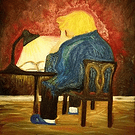DirtySpiv
I need to draw a ruler over 2D view in my app, what is the best way to do it with Urho?

I need to draw a ruler over 2D view in my app, what is the best way to do it with Urho?

If you can’t get what you want by applying a texture to a sprite/button, or even combining a bunch of ui elements, then you might want to subclass Button and override the GetBatches functions. Here’s a wip class for a custom bezier curve:
#include "UICurve.h"
UICurve::UICurve(Context* context) : Sprite(context)
{
context->RegisterFactory<UICurve>("UI");
};
void UICurve::GetBatches(PODVector<UIBatch>& batches, PODVector<float>& vertexData, const IntRect& currentScissor)
{
if (pathQuads.Size() < 4)
return;
bool allOpaque = true;
if (GetDerivedOpacity() < 1.0f || color_[C_TOPLEFT].a_ < 1.0f || color_[C_TOPRIGHT].a_ < 1.0f ||
color_[C_BOTTOMLEFT].a_ < 1.0f || color_[C_BOTTOMRIGHT].a_ < 1.0f)
allOpaque = false;
const IntVector2& size = GetSize();
UIBatch
batch(this, blendMode_ == BLEND_REPLACE && !allOpaque ? BLEND_ALPHA : blendMode_, currentScissor, texture_, &vertexData);
//iterate over pathQuads and push to batch
for (int i = 0; i < pathQuads.Size()/4; i ++)
{
//adjust ordering for render
Vector3 a = pathQuads[4 * i];
Vector3 b = pathQuads[4 * i + 1];
Vector3 c = pathQuads[4 * i + 2];
Vector3 d = pathQuads[4 * i + 3];
AddCurveSegment(batch, a, b, c, d);
}
UIBatch::AddOrMerge(batch, batches);
// Reset hovering for next frame
hovering_ = false;
}
void UICurve::Update(float timeStep)
{
}
void UICurve::UpdatePath()
{
BezierCurve(segments_);
OffsetCurve(thickness_);
}
void UICurve::SetStartPoint(Vector3 newPos, bool moveTangent)
{
if (controlPoints.Size() < 4)
{
URHO3D_LOGERROR("Control points have not been initialize.");
return;
}
//get move vec
Vector3 tan = controlPoints[1] - controlPoints[0];
Vector3 vec = newPos - controlPoints[0];
controlPoints[0] = newPos;
if (moveTangent)
{
float d = 0.5f *(controlPoints[3] - controlPoints[0]).Length();
d = Clamp(d, 0.0f, 300.0f);
controlPoints[1] = controlPoints[0] + d * tan.Normalized();
}
UpdatePath();
}
void UICurve::SetEndPoint(Vector3 newPos, bool moveTangent)
{
if (controlPoints.Size() < 4)
{
URHO3D_LOGERROR("Control points have not been initialize.");
return;
}
//get move vec
Vector3 tan = controlPoints[2] - controlPoints[3];
Vector3 vec = newPos - controlPoints[3];
controlPoints[3] = newPos;
if (moveTangent)
{
float d = 0.5f * (controlPoints[3] - controlPoints[0]).Length();
d = Clamp(d, 0.0f, 300.0f);
controlPoints[2] = controlPoints[3] + d * tan.Normalized();
}
UpdatePath();
}
void UICurve::BezierCurve(int segments)
{
int num_segments = segments;
segments_ = segments;
float t_step = 1.0f / (float)num_segments;
//check that we have the right number of control points
if (controlPoints.Size() < 4)
{
URHO3D_LOGERROR("Not enough control points for Bezier curve");
return;
}
//clear the path verts
pathVerts.Clear();
//push the first point
pathVerts.Push(controlPoints[0]);
for (int i_step = 1; i_step <= num_segments; i_step++)
{
float t = t_step * i_step;
float u = 1.0f - t;
float w1 = u*u*u;
float w2 = 3 * u*u*t;
float w3 = 3 * u*t*t;
float w4 = t*t*t;
Vector3 nextVert(w1*controlPoints[0].x_ + w2*controlPoints[1].x_ + w3*controlPoints[2].x_ + w4*controlPoints[3].x_,
w1*controlPoints[0].y_ + w2*controlPoints[1].y_ + w3*controlPoints[2].y_ + w4*controlPoints[3].y_);
//push the next pt
pathVerts.Push(nextVert);
}
//mark the curve for redraw
isDirty = true;
}
void UICurve::OffsetCurve(float thickness)
{
//check that path verts has a least two points
if (pathVerts.Size() < 2)
{
URHO3D_LOGERROR("Not enough path verts for curve offset");
return;
}
thickness_ = thickness;
//clear
pathQuads.Clear();
//create the perp lines
//ordering is
/*************************************************************
0 1
| |
|----------|---------- etc
| |
2 3
*************************************************************/
for (int i = 0; i < pathVerts.Size()-1; i++)
{
if (i == 0)
{
Vector3 dirVec = pathVerts[i + 1] - pathVerts[i];
Vector3 perpVec(dirVec.y_, -dirVec.x_, 0);
perpVec.Normalize();
Vector3 p1 = pathVerts[i] + thickness * perpVec;
Vector3 p2 = pathVerts[i] - thickness * perpVec;
Vector3 p3 = pathVerts[i + 1] + thickness * perpVec;
Vector3 p4 = pathVerts[i + 1] - thickness * perpVec;
//push
pathQuads.Push(p1);
pathQuads.Push(p3);
pathQuads.Push(p2);
pathQuads.Push(p4);
}
else if (i == pathVerts.Size() - 2)
{
Vector3 dirVec = pathVerts[i] - pathVerts[i - 1];
Vector3 perpVec(dirVec.y_, -dirVec.x_, 0);
perpVec.Normalize();
Vector3 p1 = pathVerts[i] + thickness * perpVec;
Vector3 p2 = pathVerts[i] - thickness * perpVec;
Vector3 p3 = pathVerts[i + 1] + thickness * perpVec;
Vector3 p4 = pathVerts[i + 1] - thickness * perpVec;
//push
pathQuads.Push(p1);
pathQuads.Push(p3);
pathQuads.Push(p2);
pathQuads.Push(p4);
}
else
{
Vector3 dirVec = pathVerts[i + 1] - pathVerts[i];
Vector3 perpVec(dirVec.y_, -dirVec.x_, 0);
perpVec.Normalize();
Vector3 p1 = pathVerts[i] + thickness * perpVec;
Vector3 p2 = pathVerts[i] - thickness * perpVec;
Vector3 p3 = pathVerts[i + 1] + thickness * perpVec;
Vector3 p4 = pathVerts[i + 1] - thickness * perpVec;
//push
pathQuads.Push(p1);
pathQuads.Push(p3);
pathQuads.Push(p2);
pathQuads.Push(p4);
}
}
}
//void UICurve::BezierCurve(UIBatch& batch, Vector3 a, Vector3 b, Vector3 c, Vector3 d)
//{
// int num_segments = 50;
// float t_step = 1.0f / (float)num_segments;
//
// Vector3 v1, v2, v3, v4;
// v1 = a;
// for (int i_step = 1; i_step <= num_segments; i_step++)
// {
// float t = t_step * i_step;
// float u = 1.0f - t;
// float w1 = u*u*u;
// float w2 = 3 * u*u*t;
// float w3 = 3 * u*t*t;
// float w4 = t*t*t;
//
// v2 = Vector3(w1*a.x_ + w2*b.x_ + w3*c.x_ + w4*d.x_, w1*a.y_ + w2*b.y_ + w3*c.y_ + w4*d.y_);
//
// //URHO3D_LOGINFO("bezier pt: " + String(b));
//
// v3 = v2 + Vector3(0, 20, 0);
// v4 = v1 + Vector3(0, 20, 0);
//
// AddCurveSegment(batch, v1, v2, v4, v3);
// v1 = v2;
//
//
// }
//}
void UICurve::AddCurveSegment(UIBatch& batch, Vector3 a, Vector3 b, Vector3 c, Vector3 d)
{
//args
int x = 0;
int y = 0;
const IntVector2& size = GetSize();
int width = size.x_;
int height = size.y_;
Matrix3x4 transform = GetTransform();
int texOffsetX = imageRect_.left_;
int texOffsetY = imageRect_.top_;
int texWidth = imageRect_.right_ - imageRect_.left_;
int texHeight = imageRect_.bottom_ - imageRect_.top_;
//URHO3D_LOGINFO("a: " + String(a) + ",b: " + String(b) + ",c: " + String(c) + ",d: " + String(d));
//logic
unsigned topLeftColor, topRightColor, bottomLeftColor, bottomRightColor;
if (!batch.useGradient_)
{
// If alpha is 0, nothing will be rendered, so do not add the quad
if (!(batch.color_ & 0xff000000))
return;
topLeftColor = batch.color_;
topRightColor = batch.color_;
bottomLeftColor = batch.color_;
bottomRightColor = batch.color_;
}
else
{
topLeftColor = batch.GetInterpolatedColor(x, y);
topRightColor = batch.GetInterpolatedColor(x + width, y);
bottomLeftColor = batch.GetInterpolatedColor(x, y + height);
bottomRightColor = batch.GetInterpolatedColor(x + width, y + height);
}
/* Vector3 v1 = (transform * Vector3((float)x, (float)y, 0.0f)) - batch.posAdjust;
Vector3 v2 = (transform * Vector3((float)x + (float)width, (float)y, 0.0f)) - batch.posAdjust;
Vector3 v3 = (transform * Vector3((float)x, (float)y + (float)height, 0.0f)) - batch.posAdjust;
Vector3 v4 = (transform * Vector3((float)x + (float)width, (float)y + (float)height, 0.0f)) - batch.posAdjust*/;
Vector3 v1 = (transform * a) - batch.posAdjust;
Vector3 v2 = (transform * b) - batch.posAdjust;
Vector3 v3 = (transform * c) - batch.posAdjust;
Vector3 v4 = (transform * d) - batch.posAdjust;
float leftUV = 0.0f; // ((float)texOffsetX) * batch.invTextureSize_.x_;
float topUV = 0.0f;// ((float)texOffsetY) * batch.invTextureSize_.y_;
float rightUV = 1.0f;// ((float)(texOffsetX + (texWidth ? texWidth : width))) *batch.invTextureSize_.x_;
float bottomUV = 1.0f;// ((float)(texOffsetY + (texHeight ? texHeight : height))) * batch.invTextureSize_.y_;
unsigned begin = batch.vertexData_->Size();
batch.vertexData_->Resize(begin + 6 * UI_VERTEX_SIZE);
float* dest = &(batch.vertexData_->At(begin));
batch.vertexEnd_ = batch.vertexData_->Size();
dest[0] = v1.x_;
dest[1] = v1.y_;
dest[2] = 0.0f;
((unsigned&)dest[3]) = topLeftColor;
dest[4] = leftUV;
dest[5] = topUV;
dest[6] = v2.x_;
dest[7] = v2.y_;
dest[8] = 0.0f;
((unsigned&)dest[9]) = topRightColor;
dest[10] = rightUV;
dest[11] = topUV;
dest[12] = v3.x_;
dest[13] = v3.y_;
dest[14] = 0.0f;
((unsigned&)dest[15]) = bottomLeftColor;
dest[16] = leftUV;
dest[17] = bottomUV;
dest[18] = v2.x_;
dest[19] = v2.y_;
dest[20] = 0.0f;
((unsigned&)dest[21]) = topRightColor;
dest[22] = rightUV;
dest[23] = topUV;
dest[24] = v4.x_;
dest[25] = v4.y_;
dest[26] = 0.0f;
((unsigned&)dest[27]) = bottomRightColor;
dest[28] = rightUV;
dest[29] = bottomUV;
dest[30] = v3.x_;
dest[31] = v3.y_;
dest[32] = 0.0f;
((unsigned&)dest[33]) = bottomLeftColor;
dest[34] = leftUV;
dest[35] = bottomUV;
}

I forgot to mention I’m using UrhoSharp (.net wrapper) and there is no GetBatches binding.
Is it a good idea to use ortho camera and draw ruler with shader?